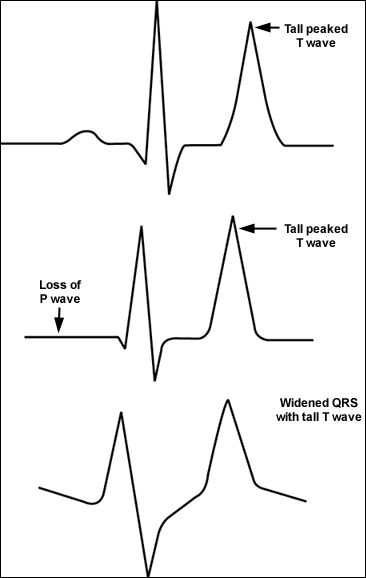Hyperkalemia resident survival guide
Editor-In-Chief: C. Michael Gibson, M.S., M.D. [1]; Associate Editor(s)-in-Chief: Rim Halaby, M.D. [2]; Mahmoud Sakr, M.D. [3]
Definition
Hyperkalemia is defined as a serum potassium concentration greater than 5.5 mEq/L in adults. Levels higher than 7 mEq/L can lead to significant hemodynamic compromise.
Causes
Life Threatening Causes
Life-threatening causes include conditions which may result in death or permanent disability within 24 hours if left untreated.
- Acute renal failure
- Adrenal insufficiency
- Diabetic ketoacidosis
- Large IV doses of calcium chloride or calcium gluconate
- Massive hemolysis
- Metabolic acidosis
- Rapid tissue necrosis
- Rhabdomyolysis
- Tumor lysis syndrome
Common Causes
- Adrenal insufficiency
- Blood transfusion
- Diabetic ketoacidosis
- Potassium supplementation (oral or IV)
- Potassium rich diet
- Medications: ACE inhibitors, angiotensin receptor blockers, amiloride, spironolactone, NSAIDS, ciclosporin, tacrolimus, trimethoprim, pentamidine, succinylcholine
- Pseudohyperkalemia
- Renal insufficiency
- Renal tubular acidosis type 4
Management
Shown below is an algorithm summarizing the approach to hyperkalemia.[1][2][3]
| Potassium > 5.5 mEq/L | |||||||||||||||||||||||||||||||||||||||||||||||||||
| If repeated potassium level is normal, check potassium level in 24 hours | R/O Pseudohyperkalemia (Artifact, hemolysis, elevated WBC, elevated RBC, elevated platelets) Repeat potassium level | ||||||||||||||||||||||||||||||||||||||||||||||||||
| Check vital signs ABC's Order an EKG Obtain a concise history and physical exam Order BUN, creatinine, glucose, ABG | |||||||||||||||||||||||||||||||||||||||||||||||||||
| Assess EKG | |||||||||||||||||||||||||||||||||||||||||||||||||||
| Presence of EKG changes Loss of P waves, peaked T waves and wide QRS  | Absence of EKG changes and Hemodynamically stable patient | ||||||||||||||||||||||||||||||||||||||||||||||||||
| Do the following steps simultaneously: 1. Myocardial stabilization IV Ca gluconate (1-2 amps) Contraindicated in digoxin toxicity and hypercalcemia 2. Shift potassium from blood into cells Insulin (0.2 units for every gram of glucose administered) and 20% dextrose ( 2.5-5 ml/kg/h) (D50 1 ampule/10unit insulin) Glucose level monitoring is needed Beta2 agonists (albuterol is given 10-20mg via nebulizer or 0.5 mg IV) 3. Lower total body potassium Cation exchange resin (kayexalate 30-90g given P.O. or P.R.) Loop diuretics (furosemide 1-2 mg/kg) Hemodialysis if refractory | |||||||||||||||||||||||||||||||||||||||||||||||||||
| Potassium > 6 mEq/L | 5.5mEq/L<Potassium<6mEq/L | ||||||||||||||||||||||||||||||||||||||||||||||||||
| Do the following steps simultaneously: 1. Monitor for cardiac arrhythmia Place the patient on a closely monitored bed for potential arrhythmias 2. Shift potassium from blood into cells Insulin (0.2 units for every gram of glucose administered) and 20%dextrose ( 2.5-5 ml/kg/h) Glucose level monitoring is needed Beta2 agonists (albuterol is given 10-20mg via nebulizer or 0.5 mg IV) 3. Lower total body potassium Cation exchange resin (kayexalate 30-90g given P.O. or P.R. Loop diuretics (furosemide 1-2 mg/kg) Hemodialysis if refractory | Lower total body potassium Cation exchange resin (kayexalate 30-90g given P.O. or P.R.) Loop diuretics (furosemide 1-2 mg/kg) | ||||||||||||||||||||||||||||||||||||||||||||||||||
| D/C any offending medications that is associated with hyperkalemia D/C oral or parenteral potassium Correct acidosis with bicarb if pH<7.2 Restrict dietary potassium intake Review potassium levels every 2-4 hours until stabilized Check levels of other electrolytes such as magnesium and phosphorus | |||||||||||||||||||||||||||||||||||||||||||||||||||
References
- ↑ Lehnhardt A, Kemper MJ (2011). "Pathogenesis, diagnosis and management of hyperkalemia". Pediatr Nephrol. 26 (3): 377–84. doi:10.1007/s00467-010-1699-3. PMC 3061004. PMID 21181208.
- ↑ Ahee P. The management of hyperkalaemia in the emergency department. J Accid Emerg Med 2000;17:188-191 doi:10.1136/emj.17.3.18
- ↑ Weisberg L. Management of severe hyperkalemia. Crit Care Med 2008 Vol. 36, No. 12.